#Set Precision of Data in chart Data Labels
Explore tagged Tumblr posts
Text

How to Structure Your ESS IA for Maximum Impact
When it comes to the ESS IA (Internal Assessment) for Environmental Systems and Societies, the way you structure your work can make or break your grade. A well-organized and thoughtful ESS IA not only impresses your teacher but also demonstrates your ability to apply critical thinking, research, and analysis in real-world contexts. In this post, we’ll guide you through the steps to structure your ESS IA for maximum impact, ensuring it stands out and fulfills the expectations of the assessment.
Planning: The Foundation of a Strong ESS IA
A strong ESS IA starts with solid planning. Before diving into your research or experiments, make sure you have a clear roadmap. Planning ahead ensures that each section of your IA connects seamlessly to the next, giving your project flow and clarity.
Choose an Engaging Topic: Begin by selecting ESS IA ideas that excite you. Your chosen topic should be something that holds your interest and aligns with the key concepts of Environmental Systems and Societies. It’s essential that your topic is both narrow enough to explore deeply but broad enough to allow for meaningful analysis.
Formulate a Clear Research Question: Once you’ve picked a topic, it’s time to define your research question. The question should be specific, focused, and aligned with the core themes of the ESS IA. Make sure it can be answered through primary or secondary data.
Create a Timeline: A well-thought-out timeline helps you stay on track and organized. Allocate time for each stage of your ESS IA, including research, data collection, analysis, and writing. Factor in time for revisions as well.
Structuring Your ESS IA: Key Sections to Focus On
The ESS IA is divided into distinct sections, each requiring attention to detail. The following is a breakdown of the key sections and how to structure them effectively.
Introduction: Setting the Scene
The introduction sets the stage for your ESS IA by providing background information and explaining why your research question matters in the context of Environmental Systems and Societies.
Contextualize Your Research: Introduce your chosen topic and explain its relevance. Discuss how your research fits into broader environmental or societal issues.
State the Research Question: Clearly present your research question. Be precise and ensure it directly addresses the aim of your investigation.
Outline Objectives: Briefly state the objectives of your IA. What are you trying to discover or prove?
Methodology: How You’ll Conduct Your Research
The methodology section of your ESS IA details the process you will follow to collect and analyze data. This section is crucial for demonstrating the reliability and validity of your results.
Explain Your Methods: Describe the methods you will use to gather data. Will it be through fieldwork, surveys, experiments, or secondary research? Be specific about your approach.
Justify Your Choices: Explain why you’ve chosen these methods. How do they align with your research question? Why are they the best tools for the job?
Discuss Variables: In case of an experiment, mention the variables you will manipulate and measure. This ensures clarity in your experimental design.

Data Collection and Analysis: Presenting Your Findings
In this section, the data you gather is presented and analyzed. This is where your hard work pays off, and you show the depth of your investigation.
Present Your Data: Organize your data in tables, graphs, or charts. Be sure to label everything clearly and reference your sources where applicable.
Interpret Your Findings: Analyze the data objectively. Does it support your research question? Look for patterns, trends, or correlations in the data and explain their significance.
Discuss Errors and Limitations: Acknowledge any possible errors in your data collection or analysis and discuss how they could affect the outcome of your research. This shows your ability to critically evaluate your own work.
Conclusion: Wrapping Up Your ESS IA
The conclusion brings your ESS IA to a close by summarizing your findings and reflecting on the research process.
Summarize Key Findings: Revisit your research question and summarize the main findings of your investigation. Did you answer your research question effectively?
Discuss Implications: What do your findings mean in the context of Environmental Systems and Societies? How do they contribute to our understanding of the environmental issue you studied?
Propose Further Research: Often, your findings will open the door for additional research. Suggest areas where further studies could expand on your work or address unresolved questions.
Environmental Systems and Societies strongly believes that the key to a successful ESS IA ideas in thorough planning, clear structure, and attention to detail. By following these steps, you can create an engaging and well-organized project that demonstrates both your understanding of environmental systems and your research skills. Keep in mind that the ESS IA is not just about answering a question; it’s about showing your ability to investigate, analyze, and reflect on environmental issues critically.
0 notes
Text
Scientific Poster Design Services for MBA Students in the UK | Tutors India
Introduction
For MBA students in the UK, the journey of academic success goes beyond writing a dissertation. One of the most important, yet often overlooked, components of research communication is the scientific poster presentation. Whether it’s part of your final assessment, an academic conference, or a departmental showcase, poster presentations offer a concise and visual way to share your research insights.
Creating an effective poster is not just about design—it’s about academic precision, structured content, and engaging visual communication. With the growing demand for high-quality presentations, Tutors India offers expert support through its Scientific Poster Presentation Services tailored for MBA students who want to stand out with confidence and clarity.
The Role of Academic Posters in MBA Research
A poster acts as a research summary, combining critical aspects such as the introduction, literature review, methodology, data analysis, and conclusions in a single-page layout. It helps communicate your MBA dissertation’s objectives and outcomes in a way that is visually engaging and academically credible.
At Tutors India, we understand the evolving needs of UK-based MBA students and provide expert Academic Poster Presentation Help to ensure your poster meets academic expectations while communicating your research effectively.
Academic posters are commonly used in:
Research symposia and conferences
Internal assessments and viva presentations
Public-facing exhibitions of student research
MBA dissertation showcases within departments
Unlike traditional dissertation submissions, poster presentations require a distinct set of skills, from graphical layout to concise writing. A poorly designed poster can reduce the impact of well-conducted research, which is why MBA students across the UK trust Tutors India and its Masters Dissertation Poster Support Services for professional assistance.
Common Challenges Faced by MBA Students
MBA students often face challenges when preparing their academic posters:
Lack of design and formatting knowledge
Difficulty summarizing complex research into visual sections
Unfamiliarity with poster structure and referencing guidelines
Trouble integrating quantitative data from SPSS, MATLAB, or R
Limited understanding of how to communicate research visually
In such cases, Tutors India’s Poster Design Services for Students help bridge the gap between great research and effective presentation.
What Tutors India Offers Through Scientific Poster Services
At Tutors India, our professional services are designed to support MBA students from start to finish. Our Scientific Poster Design Services include:
Scientific Poster Design and Layout We create compelling layouts using professional tools, ensuring visual hierarchy, formatting, and color balance that enhance academic presentation.
Content Development and Section Writing From the abstract to the results and conclusion, our academic writers develop clear, concise content that accurately represents your research objectives.
Data Visualization and Tool Integration Using visually impactful charts and graphs, we help integrate SPSS, R, or MATLAB outputs into your poster.
Poster Formatting and Referencing Support Our formatting complies with APA, Harvard, and MLA guidelines, ensuring academic accuracy and visual professionalism.
Conference-Ready Poster Delivery All outputs are prepared to meet university printing or digital submission requirements. We also assist with poster handouts for conferences and seminars.
Specialized Features for MBA Poster Presentation
With Tutors India’s Poster Presentation Services, MBA students benefit from:
Custom-designed academic posters tailored to dissertation themes
Chapter-wise development: Abstract, Methodology, Results, and more
SPSS/MATLAB integration with clear, labeled visuals
Infographic and statistical representation techniques
Turnitin-checked, plagiarism-free content
Poster critique, editing, and final proofreading
NDA-protected support ensuring full confidentiality
Why UK-Based MBA Students Choose Tutors India
Tutors India has established itself as a trusted brand for UK students. Here’s why MBA candidates rely on our Academic Poster Support Services:
Time Efficiency We handle layout, structure, and design—saving you hours of formatting work.
Academic Excellence Professionally developed posters reflect academic rigor and help boost performance.
Visual Communication Our designs communicate your research visually and clearly, perfect for evaluations and conferences.
Confidential & Plagiarism-Free All work is original, Turnitin-checked, and fully confidential under NDA agreements.
End-to-End Poster Help From initial concept to final delivery, we ensure your poster aligns with your dissertation goals and university standards.
Real Use Case: MBA Poster Success with Tutors India
An MBA student from a UK university specializing in Operations Management needed to present her SPSS-based findings on supply chain optimization. She approached Tutors India, and our team developed a clean, professional academic poster featuring her research objectives, regression analysis, and a structured conclusion. Presented during her viva, the poster earned her recognition and helped secure a high grade.
Conclusion
For MBA students in the UK, poster presentations are more than just visuals; they’re an academic communication tool. With high expectations and tight deadlines, many students benefit from professional support.
Tutors India’s Scientific Poster Presentation Services are designed to help you create a powerful, university-compliant academic poster that showcases your research effectively.
Whether you're preparing for a viva, conference, or internal showcase, trust Tutors India to deliver a well-crafted, research-driven, and eye-catching poster. Let your hard work shine with clarity, accuracy, and visual impact.
Contact Us:
UK: +44-1143520021
IN: +91 8754446690
Email: [email protected]
0 notes
Text
Why Omnimed’s 2 Inch Binders Are a Must-Have Right Now

In the fast-paced world of healthcare, where time is critical and organization is the key to saving lives, one seemingly simple tool can make all the difference: Omnimed’s 2 Inch Binders. If you're still using outdated, flimsy binders that buckle under pressure or can’t keep up with the demands of your workspace, you're risking more than just paper clutter—you're risking efficiency, compliance, and peace of mind.
Let’s get something straight: not all binders are created equal. And Omnimed’s 2 Inch Binders? They’re not just another office supply—they’re a game-changing organizational solution that’s trusted by medical professionals, administrative teams, and compliance officers across the country.
Built to Survive the Real World—Not Just the Supply Closet
Standard binders fail when you need them most. Weak spines, cheap rings, and covers that crack under stress aren’t just frustrating—they’re costly and dangerous in environments where accuracy and durability are non-negotiable. Omnimed’s 2 Inch Binders are engineered from premium materials that are made to endure the rigorous demands of clinical, industrial, and corporate settings.
These aren’t your run-of-the-mill binders. Think heavy-duty, hospital-grade, and built-to-last. Whether you’re storing sensitive patient information, regulatory documents, training manuals, or lab protocols, you can trust Omnimed’s binders to protect every page with unyielding strength.
Unmatched Capacity and Organization
You’d be surprised how much power is packed into a 2 Inch Binder. Omnimed’s precision-designed rings offer smooth page turning, jam-free closures, and maximum page retention. That means you’re not just organizing documents—you’re optimizing workflow.
Each binder is designed to hold up to 375 sheets without compromising integrity. No more fumbling with overflowing folders or trying to make room in drawers that weren’t built for chaos. With Omnimed’s 2 Inch Binders, you get streamlined storage in a sleek, accessible package.
And the best part? Omnimed offers a variety of colors and labeling options—perfect for quick identification, color-coding systems, or strict filing protocols.
Compliance Made Easy
In healthcare, documentation isn’t just important—it’s legally required. Omnimed’s 2 Inch Binders are built to meet HIPAA compliance standards, giving you peace of mind that your data is secure, professional, and easily retrievable. Whether you're preparing for an audit or organizing medical charts, you can trust Omnimed to keep you inspection-ready at a moment’s notice.
Trusted by Professionals Nationwide
Omnimed Inc has become a household name in the medical and corporate worlds because of one simple truth: they deliver products that work as hard as you do. Their 2 Inch Binders are found in thousands of hospitals, clinics, and businesses, earning praise for their rugged durability, intelligent design, and long-lasting performance.
But don’t take our word for it—ask any administrator who’s had to organize hundreds of patient files, or a compliance officer prepping for a regulatory visit. They'll tell you: Omnimed's binders never fail.
Save Time. Save Space. Save Sanity.
Let’s face it: time is your most valuable asset. Every second spent searching for a misplaced document or dealing with a broken binder is time stolen from patient care, project deadlines, or peace of mind. Omnimed’s 2 Inch Binders are a low-cost, high-impact way to regain control and boost productivity.
They don’t just help you stay organized—they transform how you work. Imagine a workspace where every file is exactly where it should be. Where transitions are seamless, audits are painless, and stress is replaced by clarity. That’s the Omnimed promise.
Don’t Wait—Stock Up Before You’re Scrambling
Here’s the deal: demand for Omnimed’s 2 Inch Binders is skyrocketing. As more healthcare facilities, research labs, and businesses upgrade their document systems, these high-performance binders are flying off the shelves. And when supply runs low, you don’t want to be left relying on inferior products that put your operations at risk.
Now is the time to take control of your organization strategy. Whether you need ten binders or ten thousand, Omnimed Inc has the stock, the quality, and the support to deliver exactly what you need—fast.
For More Details You Can Visit Us:
face mask dispenser
Splash Guard
splash shield
0 notes
Text
Amazon QuickSight Training | AWS QuickSight Training in Hyderabad
Amazon QuickSight Training: 10 QuickSight Tips & Tricks to Boost Your Data Analysis Skills
Amazon QuickSight is a powerful business intelligence (BI) tool that empowers organizations to create interactive dashboards and gain valuable insights from their data. Whether you’re new to Amazon QuickSight or looking to enhance your existing skills, mastering its advanced features can significantly improve your data analysis capabilities. This guide focuses on ten essential tips and tricks to elevate your expertise in Amazon QuickSight Training and make the most out of this tool.
1. Understanding the Basics with Amazon QuickSight Training
To effectively use QuickSight, start by understanding its fundamentals. Amazon QuickSight Training provides a thorough overview of key functionalities such as connecting data sources, creating datasets, and building visualizations. By mastering the basics, you set the foundation for leveraging more advanced features and gaining meaningful insights.
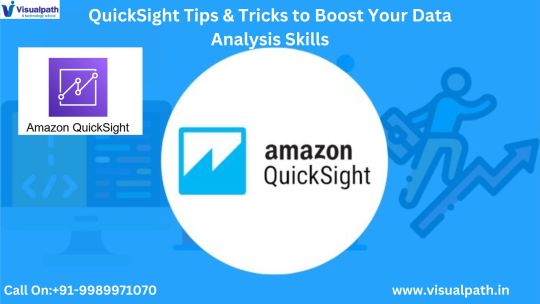
2. Optimize Data Preparation
One of the first steps in data analysis is data preparation. Use Amazon QuickSight's in-built tools to clean, transform, and model your data before creating visualizations. Features like calculated fields and data filters are especially useful for creating precise datasets. AWS QuickSight Online Training covers these capabilities in detail, helping you streamline the preparation process.
3. Mastering Visual Customization
Effective data presentation is critical for analysis. With QuickSight, you can create highly customized visuals that align with your specific needs. Learn to adjust colors, axes, and data labels to make your charts more intuitive and visually appealing. Amazon QuickSight Training emphasizes the importance of tailoring visuals to improve storytelling and engagement.
4. Utilize Advanced Calculations
QuickSight supports advanced calculations, such as percentiles, running totals, and custom metrics. Leveraging these features allows you to derive deeper insights from your data. AWS QuickSight Training provides step-by-step guidance on creating advanced formulas, which can save time and add value to your analysis.
5. Enable Auto-Narratives for Insights
Auto-narratives in QuickSight use natural language processing (NLP) to generate textual summaries of your data. This feature is particularly useful for highlighting trends, anomalies, and key performance indicators (KPIs). AWS QuickSight Online Training teaches how to enable and customize auto-narratives for improved decision-making.
6. Take Advantage of SPICE Engine
QuickSight’s Super-fast, Parallel, In-memory Calculation Engine (SPICE) is designed for speed and efficiency. It enables users to analyze massive datasets without relying on external databases. Learning how to optimize SPICE usage is an integral part of Amazon QuickSight Training and ensures you can work with data at scale.
7. Implement Conditional Formatting
Conditional formatting helps draw attention to critical data points. You can set rules to highlight values based on specific conditions, making your dashboards more actionable. AWS QuickSight Training explores how to implement these rules to enhance the interpretability of your visuals.
8. Share and Collaborate Effectively
QuickSight makes it easy to share dashboards and reports with stakeholders. By learning best practices for sharing, including granting permissions and scheduling email reports, you ensure that insights reach the right audience. AWS QuickSight Online Training includes collaboration techniques to improve team workflows.
9. Use Embedded Analytics
Embedding QuickSight dashboards into applications or websites is a game-changer for businesses. This feature allows organizations to provide real-time insights to users within their existing platforms. Amazon QuickSight Training delves into embedding analytics, offering practical examples to integrate dashboards seamlessly.
10. Stay Updated with New Features
AWS QuickSight regularly updates its features to enhance user experience and functionality. Staying informed about these updates through AWS QuickSight Training ensures you are always utilizing the latest tools and capabilities to boost productivity and efficiency.
Conclusion: Amazon QuickSight is a versatile and user-friendly BI tool that caters to a wide range of data analysis needs. By leveraging these tips and tricks, you can unlock the full potential of QuickSight and deliver impactful insights. Whether you're new to BI or an experienced analyst, Amazon QuickSight Training equips you with the skills to excel in data visualization and reporting.
AWS QuickSight Online Training and AWS QuickSight Training courses are invaluable resources for professionals looking to stay competitive in today’s data-driven world. From mastering visual customization to utilizing SPICE and embedding analytics, QuickSight offers endless opportunities for growth and innovation. With continuous learning and practice, you can transform raw data into actionable intelligence, empowering your organization to make informed decisions and drive success.
Visualpath is a top institute in Hyderabad offering AWS QuickSight Online Training with real-time expert instructors and hands-on projects. Our Amazon QuickSight Course Online, from industry experts and gain experience. We provide to individuals globally in the USA, UK, etc. To schedule a demo, call +91-9989971070.
Key Points: AWS, Amazon S3, Amazon Redshift, Amazon RDS, Amazon Athena, AWS Glue, Amazon DynamoDB, AWS IoT Analytics, ETL Tools.
Attend Free Demo
Call Now: +91-9989971070
Whatsapp: https://www.whatsapp.com/catalog/919989971070
Visit our Blog: https://visualpathblogs.com/
Visit: https://www.visualpath.in/online-amazon-quicksight-training.html
#Amazon QuickSight Training#AWS QuickSight Online Training#Amazon QuickSight Course Online#AWS QuickSight Training in Hyderabad#Amazon QuickSight Training Course#AWS QuickSight Training
0 notes
Text
How to Use a CBD Test Kit to Ensure Product Quality and Safety?
With the rise in popularity of cannabidiol (CBD), ensuring the quality and safety of CBD products has never been more important. A CBD test kit is a handy tool to help you check the potency and purity of your CBD products. Whether you’re a consumer or a seller, using a CBD test kit can provide peace of mind and help you avoid potential issues. Here’s a simple guide on how to use a CBD test kit effectively.
What is a CBD Test Kit?
A CBD test kit is a device or set of tools designed to measure the amount of CBD in a product and check for any impurities. There are different types of CBD test kits, including:
Colorimetric Kits: These use color changes to show the CBD concentration.
Chromatographic Kits: These separate and analyze the CBD from other substances for a detailed result.
Digital Testers: These provide quick, precise readings on a digital screen.
Why Use a CBD Test Kit?
Verify Potency: Make sure the amount of CBD in the product matches what’s claimed on the label.
Check Purity: Ensure the product is free from harmful contaminants like heavy metals or pesticides.
Avoid Misinformation: Prevent being misled by inaccurate product claims.
Meet Legal Standards: Ensure your CBD products comply with local regulations on THC levels and composition.
How to Use a CBD Test Kit
1. Choose the Right Kit
Pick a CBD test kit that fits your needs. If you need a quick check, a colorimetric or test strip kit might be best. For more detailed results, consider a chromatographic kit or a digital tester. Always choose a reputable brand for accuracy.
2. Prepare Your Sample
Follow the kit’s instructions for sample preparation. This might involve dissolving the CBD product in a solvent or grinding it up. Proper preparation is key to getting accurate results.
3. Perform the Test
Here’s a basic rundown of the testing process:
Mix: Combine your CBD sample with the provided chemicals or solutions.
Apply: Use the test strip, well, or digital device as instructed.
Wait: Allow time for the reaction or measurement to occur.
4. Read the Results
Once the test is complete, read the results according to the kit’s guidelines. Colorimetric kits usually involve comparing color changes to a chart. Digital testers will show results on a screen. For chromatographic kits, you might need to compare data with reference standards.
5. Record Your Findings
Keep track of the CBD concentration and any other important details. This helps verify product claims and ensures consistency across different batches.
Tips for Accurate Testing
Follow Instructions: Stick to the guidelines provided with your kit for best results.
Keep Equipment Clean: Prevent contamination by using clean tools and surfaces.
Store Samples Properly: Maintain sample quality by storing them as recommended.
Test Multiple Samples: Testing different samples can provide more reliable results.
Calibrate Digital Testers: If using a digital device, make sure it’s calibrated according to the instructions.
When to Consider Professional Testing
While home kits are useful, there are times when professional testing might be needed:
Regulatory Compliance: Businesses may need lab testing to meet legal requirements.
In-Depth Analysis: For detailed cannabinoid profiles and contamination checks, professional labs are more thorough.
Inconsistent Results: If home tests show varying results, professional labs can offer confirmation.
Conclusion
Using a CBD test kit is an excellent way to ensure your CBD products are both safe and effective. By choosing the right kit, following the instructions carefully, and understanding your results, you can verify the quality of your CBD products and avoid potential issues. Whether for personal use or in a business setting, regular testing helps maintain high standards and ensures a better CBD experience.
1 note
·
View note
Text
Data Visualization: Striking the Right Balance between Accuracy and Impact
In today’s data-oriented world, data visualization ethics plays a significant as a tool for successfully passing on important information, hence helping organizations in their communication efforts. However, this ability carries a substantial responsibility — the commitment to guarantee that data visualizations not only impart knowledge but are also accountable for ethical standards.

The Role of Data Visualization Ethics
In our digitized world of data where decision-making is the driving force, the significance of ethics can not be overhyped. Ethical data visualization safeguards that information is not only presented perfectly but also accurately, and fairly and is free of misleading interpretations. Let’s explain the importance with an example:
Example: COVID-19 Statistics Dashboard
During the COVID-19 pandemic, data dashboards monitoring infection rates, fatalities, and vaccination advancements appeared as vital resources for both public health authorities and the broader population. Now, visualise a situation in which the data visualization on a particular dashboard disregards ethical principles:
Ethical Data Visualization:
In an ethically designed COVID-19 dashboard:
Precise Depiction: The charts and graphs represent the data accurately, followed by appropriately labelled scales.
Transparency: There is complete transparency in data sources and methodology for data collection and reporting.
Context: The dashboard comprises contexts, such as population demographics or testing rates, that allow users to interpret the data accurately.
Fairness: There is no error in data and all the demographic groups and regions are fairly represented in the best possible way.
Responsibility: The dashboard creators responsibly update it regularly to show the latest information and address any errors.
Unethical Data Visualization:
Now, pay attention to an unethical approach to the same dashboard:
False Scale: The dashboard uses a deceptive scale on a graph, overstating the increase in cases or deaths which will be completely fake.
Biased Data Selection: It displays only the selected data points that support a particular narrative, while the most accurate and relevant data is absent.
Lack of Context: The dashboard lacks context, which leads to inaccurate conclusions regarding the brutality of the situation by the users.
Data Mismanagement: Data is manipulated to tone down the effect of the virus, possibly putting public health at a bigger risk.
Wrong Reporting: The data report is misleading as errors and inaccuracies are ignored leading to incorrect conclusions about the status of the pandemic.
In conclusion, the role of ethical data visualization is misunderstood by its ability to influence public perception, simplify well-informed choices, and support credibility. In high-stakes situations like pandemics where accurate and error-free data is of great significance as it can be a matter of life and death. Ethical data visualization assures that data is not only visually engaging but also reliable, unbiased, and of utmost trust.
Definition
In this world of data-driven insights, defining data visualization ethics is of paramount importance. These ethical standards provide the basis for creating visual representations that are not limited to being informative but are also truthful and fair enough. Let’s discover this with a real-world example:
Example: Climate Change Data Visualization
It is always about ensuring that data-driven narratives, in critical areas like climate change are best characterized by accuracy, transparency, fairness and greatest responsibility. These ethical principles act as the foundation for creating visuals that inspire action are responsible for making decisions and are not only confined to informing.
Challenges
A set of unique challenges is often represented by navigating the complexities. The reason why these challenges arise is the need to balance between the pursuit of insightful and impactful visuals while maintaining ethical standards. Let us uncover these challenges with a live example:
Example: COVID-19 Data Presentation
Assume a scenario of data visualization is implemented to portray the effect of the COVID-19 pandemic. As a result, various challenges in ethics become clear.
1. Selection of Biased Data:
Challenge: The real challenge is selecting which data to visualize. Bias may unintentionally creep in, which may lead to the underrepresentation of certain regions or groups.
Example: If data from densely populated urban areas are paid attention to whereas rural areas are not taken into consideration. Due to this, it can give misleading pictures to viewers about the pandemic’s true spread.
2. Ambiguous Scales and Visual Tricks:
Challenge: Making visuals that inadvertently overstate or restrain the significance of data points.
Example: Unnecessary panic can be induced potentially by using a non-linear scale on a graph to make a slight increase in cases that display a steep rise.
3. Selected Data:
Challenge: Only present the selective data points that offer support to a specific story while the rest of the others are left out.
Example: A false impression regarding the pandemic’s trajectory is given by highlighting a brief decline in cases without mentioning the overall increase in an upward trend.
4. Lack of Context:
Challenge: Misinterpretation is possible when adequate context for data fails.
Example: Assessing the true severity of the pandemic can be so challenging when the daily number of cases is considered without testing rates.
5. Data Mismanagement:
Challenge: To support a particular agenda, there is deliberate manipulation of data.
Example: Influencing public behaviour inappropriately by altering the scale of a graph to give a picture that the pandemic is under control.
These challenges underline the critical need for data visualization practitioners to follow ethical principles thoroughly. During COVID-19 data visualization, keeping accuracy, transparency, fairness, and responsibility in presenting information is indispensable to confirm that the public receives consistent and reliable understandings during a health crisis.
Transparency in Data Visualization: Informative Intentions
A fine line is required to strike a balance between creating useful and engaging visuals while maintaining ethical standards. We can explore the key factors involved in maintaining this fine line:
Picking the Correct Graphic Picture: One of the most important features of ethical data visualization is choosing the appropriate visual representation for your data. Make sure that the chosen chart or graph exhibits the message without alteration.
Matching Aesthetics and Clarity: Although aesthetics can make a visualization visually appealing, it is indispensable not to negotiate clarity for the sake of design. Focus on clarity needs to be maintained to prevent misinterpretation.
Framing Data Appropriately: Context plays a pivotal role in data visualization ethics that includes context, such as background information or relevant benchmarks, and ultimately helps viewers to recognise the significance of the data.
Transparent Data Attribution: To cross the fine line ethically, transparency about data sources and methodologies is of paramount importance. Undoubtedly displays from where the data comes and how it is being collected to make sure viewers can trust the information.
Audience-Centric Approach: Modify your data visualization to the target audience. Make it possible that it speaks to their level of expertise and provides information that is useful and relevant to them at every level.
Frequently Updating Visuals: In dynamic situations, like developing events or ongoing research, make sure to update your visuals regularly to make sure they show the most existing data. Old information can depict inaccurate interpretations.
Helping Data Literacy: Boost data literacy among your audience by way of providing explanations, labels, and legends that help viewers understand the visualization properly.
These factors need to be considered and maintained to achieve a commitment to ethical principles. You can successfully define the fine line in data visualization and verify that your visuals are not only engaging but also reliable and useful for your audience.
Conclusion
Data visualization is a serious pillar in our data-driven world. It underlines the responsibility of data practitioners to create visuals that not only inform but also support the highest ethical standards. Data visualizations ethics, encompassing both ethical and unethical data visualization, is not merely limited to a trend or a set of guidelines; it is a crucial framework that confirms that data-driven descriptions are grounded in certainty, transparency, equality, and responsibility.
0 notes
Text
Tips for Mastering Machine Learning Algorithms
Machine learning (ML) is a powerful and exciting field that is transforming industries and driving innovation. At St Mary's Group of Institutions, the best engineering college in Hyderabad, we are dedicated to helping our students master machine learning algorithms. Here are some simple yet effective tips to help you excel in this fascinating domain.
1. Understand the Basics
Before diving into complex algorithms, it’s crucial to have a strong grasp of the fundamentals. Make sure you understand basic concepts like supervised and unsupervised learning, regression, classification, and clustering. Familiarize yourself with terms such as features, labels, and training sets.
2. Learn Programming Languages
Proficiency in programming languages like Python and R is essential for working with machine learning algorithms. Python, in particular, is widely used due to its simplicity and the vast number of libraries available for ML, such as TensorFlow, Keras, and Scikit-learn.
3. Study Algorithms One at a Time
There are many machine learning algorithms, each with its own strengths and applications. Start by learning one algorithm at a time. For instance, begin with linear regression before moving on to more complex ones like decision trees, support vector machines, and neural networks. Understand how each algorithm works, its assumptions, and its limitations.
4. Hands-On Practice
Theory alone isn’t enough; hands-on practice is crucial. Work on real datasets and apply the algorithms you learn. Kaggle is a great platform for finding datasets and participating in competitions. Practical experience will help you understand the nuances and challenges of implementing machine learning algorithms.
5. Use Visualization Tools
Visualizing data and model outputs can provide valuable insights. Tools like Matplotlib, Seaborn, and Tableau can help you create graphs and charts that make it easier to understand data distributions, patterns, and the performance of your algorithms.
6. Understand Evaluation Metrics
Knowing how to evaluate your models is vital. Learn about different metrics such as accuracy, precision, recall, F1 score, and ROC-AUC. These metrics help you determine how well your model is performing and where improvements are needed.
7. Keep Up with the Latest Research
Machine learning is a rapidly evolving field. Stay updated with the latest research and advancements by reading papers, attending conferences, and following influential researchers and organizations in the field. Websites like arXiv and Google Scholar are excellent resources.
8. Collaborate and Network
Collaborating with peers and joining online forums or study groups can provide support and new perspectives. Platforms like GitHub, Stack Overflow, and LinkedIn offer opportunities to connect with other machine learning enthusiasts and professionals.
Conclusion
Mastering machine learning algorithms takes time, patience, and consistent effort. By understanding the basics, practicing regularly, and staying updated with the latest developments, you can build a strong foundation in machine learning. At St Mary's Group of Institutions, we are committed to providing the resources and support you need to succeed in this exciting field. Embrace these tips, and you’ll be well on your way to becoming proficient in machine learning algorithms.
#best btech colleges in india#btech course#artificial intelligence#ai ml development services#aimlsolutions#machinelearning
0 notes
Text
Healthcare Technology
Medical laboratories play a crucial role in healthcare by performing tests on clinical specimens to obtain information about patients' health. These laboratories are equipped with advanced technology and staffed by skilled professionals who conduct a wide range of diagnostic tests, from routine blood work to complex genetic analyses. The results from these tests are essential for diagnosing diseases, monitoring patient health, and guiding treatment decisions. By providing accurate and timely data, medical laboratories contribute significantly to patient care and the overall effectiveness of the healthcare system.
Some types of healthcare technology:-
Electronic Health Records (EHRs): Digital versions of patients' paper charts, allowing for real-time, patient-centered records accessible instantly and securely.
Telemedicine: Platforms that enable remote consultations and medical services through video conferencing and online communication.
Wearable Health Devices: Gadgets like fitness trackers and smartwatches that monitor health metrics such as heart rate, physical activity, and sleep patterns.
Medical Imaging Technology: Advanced systems such as MRI, CT scans, and X-rays that provide detailed images of the body for accurate diagnosis and treatment planning.
Robotic Surgery: Robots that assist in performing precise surgical procedures, often minimally invasive, improving recovery times and outcomes.
Health Information Systems: Software that manages healthcare data, including patient information, billing, and scheduling, to enhance operational efficiency.
Artificial Intelligence (AI) in Healthcare: AI-powered tools for diagnostics, predictive analytics, and personalized treatment plans.
Mobile Health Apps: Applications that offer health-related services and information on smartphones, helping users manage their health and wellness.
Clinical Decision Support Systems (CDSS): Software that provides healthcare professionals with knowledge and person-specific information to enhance decision-making in clinical settings.
Pharmacy Automation: Technologies that automate the dispensing, packaging, and labeling of medications to improve accuracy and efficiency in pharmacies.
Laboratory Information Management Systems (LIMS): Systems that manage samples, associated data, and laboratory workflows to ensure high-quality results and regulatory compliance.
Patient Portals: Online platforms that allow patients to access their health records, communicate with healthcare providers, and manage appointments.
3D Printing in Healthcare: The use of 3D printing technology to create medical devices, prosthetics, and even bioprinted tissues and organs.
Virtual Reality (VR) and Augmented Reality (AR): Technologies used for medical training, patient rehabilitation, and even in surgical procedures for enhanced visualization.
Remote Patient Monitoring (RPM): Devices and applications that track patients' health data from home and send it to healthcare providers for ongoing monitoring and management.
Source:- https://www.biomedicaworld.com/
0 notes
Text
PPC Dashboard | ReportGarden

In the fast-paced world of digital advertising, managing pay-per-click (PPC) campaigns requires precision, agility, and actionable insights. With ReportGarden's innovative PPC dashboard, you can harness the full potential of your PPC campaigns and drive superior results for your clients or stakeholders.
Key Features of ReportGarden's PPC Dashboard:
1. Comprehensive Performance Metrics: Track the performance of your PPC campaigns with ease using ReportGarden's PPC Dashboard. Gain insights into crucial metrics such as click-through rate (CTR), cost per click (CPC), conversion rate, return on ad spend (ROAS), and more. With real-time data updates and customizable dashboards, you can monitor campaign performance and make data-driven decisions to optimize your PPC strategies.
2. Multi-Channel Integration: ReportGarden's PPC Dashboard supports integration with leading PPC platforms, including Google Ads, Bing Ads, Facebook Ads, LinkedIn Ads, and more. Consolidate data from multiple advertising channels into a single, unified dashboard, eliminating the need to switch between different platforms. Streamline your reporting process and gain a holistic view of your PPC performance across all channels.
3. Customizable Visualization: Tailor your PPC Dashboard to suit your unique reporting needs with ReportGarden's customizable visualization options. Choose from a variety of chart types, including line graphs, bar charts, pie charts, and heatmaps, to visualize your PPC data in the most meaningful way. Customize colors, labels, and formatting to create visually appealing reports that resonate with your audience.
4. Automated Reporting: Say goodbye to manual report generation and tedious data entry tasks with ReportGarden's automated reporting capabilities. Our PPC Dashboard allows you to schedule recurring reports, automate data import from PPC platforms, and deliver reports directly to clients' inboxes. Spend less time on administrative tasks and more time on optimizing your PPC campaigns for maximum performance.
5. Client-Friendly Reports: Impress clients with professional-grade PPC reports that clearly communicate the value of your services. ReportGarden's PPC Dashboard generates client-friendly reports with intuitive visualizations, actionable insights, and custom branding options. Empower clients to understand their PPC performance and make informed decisions about their advertising budgets.
6. Real-Time Alerts and Notifications: Stay informed about changes in your PPC performance with ReportGarden's real-time alerts and notifications. Set up custom alerts for important metrics such as budget overspend, ad performance anomalies, and campaign status changes. Receive instant notifications via email or SMS, allowing you to take immediate action to address any issues or opportunities.
With ReportGarden PPC Dashboard, you can take your PPC campaigns to new heights, drive better results for your clients, and achieve your advertising goals with confidence. Sign up for ReportGarden today and experience the power of data driven PPC management.
#client reporting#social media dashboards#b2b marketing analytics dashboards#social media analytics dashboard#report automation
0 notes
Text
Exploring FileMaker’s Interface Design and Layout Tools
The user interface plays a crucial role in the design of any application, and it must be both user-friendly and have a modern aesthetic "look and feel." FileMaker is a pivotal relational database application that provides a powerful combination of a database engine and a comprehensive set of UI design tools. These tools enable developers to create layouts with exceptional efficiency, thanks to their intuitive drag-and-drop features, which surpass alternative options in terms of both speed and ease of use.
The user interface holds immense importance in the design of any application, and needs to be user-friendly with a modern aesthetic “look and feel”. FileMaker stands as a pivotal relational database application, offering a potent blend of a database engine and comprehensive UI design tools. These tools empower developers to construct layouts with remarkable efficiency, thanks to intuitive drag-and-drop features that outpace alternatives in terms of speed and simplicity.
Layout and Tools Within FileMaker, the layout feature lets you create personalized screen designs, tailored to specific needs. The layout assistant aids in selecting layouts across device formats. Depending on the devices used in the business, layout stencils for computers, touchscreens, and printers can be selected. The application also provides options for crafting print layouts, including labels, envelopes, and reports. Additionally, list and table views can be instantly created. Associated tools can be effortlessly integrated or added to the layout to facilitate this process. Elements such as text fields, buttons, images, tabs, and slider panels can be easily dragged and dropped from the toolbar.
Charts FileMaker’s chart control simplifies the creation of various chart types, such as pie charts, area charts, and bar charts. These charts can be swiftly configured to represent backend data. The chart inspector offers an array of formatting options, allowing users to customize the type, category labels, legends, and data. These charts can be quickly generated from the table view.
Web Viewer The web viewer control can easily display webpages within the FileMaker application. It is highly customizable, capable of showcasing web pages based on the data within the application. For example, it can display a company’s website or show a map based on addresses stored in the application. Advanced capabilities also allow integration with JavaScript.
Inspector The inspector, found in the toolbar, gives you the ability to modify properties of objects added to the layout. It encompasses four main sections: a. Position: Allows precise arrangement and alignment of objects. b. Styles: Customization of themes and styles. c. Appearance: Encompasses formatting options for graphics, text, paragraphs, and tabs. d. Data: Involves data binding, control style, and data formatting options.
Objects Pane With Objects pane, you can easily drag & drop fields and search objects on layout. You can also manage the placement of fields on the layout.
Add-ons FileMaker offers pre-built functional modules known as add-ons, provided by Claris, which can be seamlessly integrated into your solution. These add-ons come complete with tables, fields, scripts, and layout elements such as buttons, headers, and footers. They significantly expedite development by enhancing efficiency in managing addresses, calendars, action items, and more.
Themes FileMaker includes built-in themes that can be applied to the overall layout and objects within it, including labels, buttons, and portals. These themes can be tailored to specific needs, allowing the application of relevant styles and ensuring consistency throughout the FileMaker solution. In conclusion, FileMaker offers a rapid application low code platform to create great User Interfaces. Utilizing FileMaker’s layout design options and tools significantly enhances application design. Themes, add-ons, and charts collectively contribute to delivering an intuitive user experience. MetaSys has certified FileMaker professionals who have experience in building apps for clients across different sectors. To know more about our capabilities, visit https://www.metasyssoftware.com/technologies/filemaker/
0 notes
Text
Understanding Tableau Data Types: The Key to Effective Visualizations

If you’re diving into Tableau, one of the most important concepts to grasp early on is how Tableau handles different types of data. Data types are fundamental because they tell Tableau how to interpret your information, which directly influences everything from filtering and grouping to analysis and dashboard design.
Whether you’re a beginner or enrolled in the Best Tableau Training in Chandigarh, mastering data types will help you avoid common pitfalls and build accurate, insightful dashboards. In this guide, we’ll explore Tableau’s key data types with clear examples and practical advice on when and how to use each.
Why Do Data Types Matter in Tableau?
Before getting into the details, let’s understand why data types are so important. Each field in Tableau is assigned a data type, guiding the software on how to treat the data. When your data types are set correctly, you’ll be able to perform precise calculations, apply the right filters, and create visualizations that truly represent your data story.
Imagine trying to calculate total sales from a field that Tableau mistakenly treats as text. This would lead to errors and confusion. Similarly, mapping location data won’t work properly unless Tableau recognizes it as geographic data.
Correct data types mean your dashboards run smoothly, your insights are trustworthy, and your analysis is meaningful.
The Six Main Data Types in Tableau
Here’s a straightforward look at the primary data types you’ll encounter in Tableau and how they fit into your projects.
1. String (Text)
String data includes any combination of letters, numbers, or symbols treated as text. This typically covers names, codes, or categorical labels.
Example: Customer Name, Region, Product Code.
You’ll use strings mainly for grouping, labeling, and filtering. For example, if you want to show sales by region, “Region” will be a string field to categorize the data correctly.
Tip: Keep an eye on case sensitivity with strings, as Tableau treats “USA” and “usa” differently. Consistent formatting here is essential.
2. Number (Integer and Decimal)
Numbers are vital for calculations and metrics. Tableau distinguishes between whole numbers (integers) and decimals (floating-point).
Example: Order Quantity (100), Revenue (250.75).
Numbers allow you to calculate totals, averages, percentages, and more. These fields form the backbone of KPIs and trend charts.
Tip: Always verify that Tableau recognizes your numbers correctly. Mistaking decimals for whole numbers can skew your calculations.
3. Date and Time
Date/time data lets Tableau understand when events occur, enabling powerful chronological analysis.
Example: Order Date (“2024-06-01”), Time (“12:30 PM”).
Using date and time fields, you can analyze trends over days, months, or years, spot seasonal patterns, and compare performance across periods.
Tip: Tableau automatically groups dates into years, quarters, months, or days, making it easier to explore data at different time scales.
4. Boolean
Boolean data has only two values: TRUE or FALSE. It’s perfect for yes/no or on/off situations.
Example: Is Active, Is New Customer.
Boolean fields are useful for filters and logical calculations, such as isolating all active customers or highlighting overdue payments.
Tip: You can create Boolean fields with calculated formulas like [Sales] > 1000 to flag high-value transactions.
5. Geographic
Tableau shines with geographic data, automatically mapping locations for spatial analysis.
Example: Country, State, ZIP Code, Latitude/Longitude.
Geographic data types enable map visualizations that reveal patterns by region, helping with customer distribution, sales territories, and more.
Tip: While Tableau often auto-detects geographic roles, verify and adjust them to ensure your maps are accurate and meaningful.
6. Cluster or Mixed Data Type
Sometimes, Tableau encounters fields that mix data types, often in raw or unstructured datasets.
Example: A field containing both text and numbers.
Mixed data types can slow down analysis or cause errors, so it’s best to clean or split these fields before visualizing.
Tip: Use data preparation tools or calculated fields to separate mixed types for smoother Tableau performance.
How to Identify and Change Data Types in Tableau
Tableau typically assigns data types automatically when you connect your data source, but it’s not always perfect. You can easily check and change data types by:
Right-clicking the field in the Data Pane
Selecting “Change Data Type”
Choosing the correct type from the dropdown list
Correcting data types early prevents errors, improves dashboard speed, and helps Tableau recommend the best visualization types for your data.
Conclusion
Data types are the foundation of effective data visualization in Tableau. Knowing how to identify, modify, and apply them correctly sets you apart as a skilled user who builds dashboards that are not only visually attractive but also accurate and insightful.
Whether you’re learning on your own or taking the Best Tableau Training in Chandigarh, start by practicing with sample datasets and focusing on data types. This small but vital step will unlock clearer insights and smoother analysis.
Remember, great dashboards begin with great data management. Master data types today, and watch your Tableau skills—and your data’s impact—grow.
0 notes
Text
Visualize, Optimize, Succeed: The Power of a Visual Workflow Builder
In the dynamic realm of modern business, success hinges on the ability to streamline processes for optimal efficiency. Enter the Visual Workflow Builder – a technological marvel that empowers organizations to transform complexity into clarity, chaos into order, and ideas into tangible results. In this blog, we'll delve into the transformative power of a Visual Workflow Builder and how it paves the way for visualization, optimization, and ultimately, success.

Unleashing the Potential of a Visual Workflow Builder
Imagine having the ability to sculpt intricate processes with the stroke of a digital brush. A Visual Workflow Builder is the canvas on which you can craft, design, and refine workflows with unparalleled ease. This tool empowers even those without technical expertise to create, manage, and optimize workflows, heralding a new era of efficiency and innovation.
The Triad of Power: Visualize, Optimize, Succeed
Visualize the Process: The saying "a picture is worth a thousand words" holds true in the world of workflows. With a Visual Workflow Builder, you can transform abstract processes into visual representations. Nodes, arrows, and labels create a visual roadmap that's easy to follow, even for those unfamiliar with the process.
Optimize with Precision: Just as a sculptor fine-tunes every detail, a Visual Workflow Builder allows for meticulous optimization. Drag-and-drop elements, define decision points, and set triggers for automation. This precision ensures that processes are lean, efficient, and aligned with organizational goals.
Succeed with Confidence: Success is a journey, and a Visual Workflow Builder is your guide. By translating complex processes into visual maps, you're equipped to make informed decisions, allocate resources effectively, and identify areas for improvement. This confidence becomes the catalyst for achieving your desired outcomes.
Embarking on the Path to Success with a Visual Workflow Builder
Identify Processes: Start by identifying processes that could benefit from visualization and optimization. These could range from customer journeys to internal approval processes.
Map the Workflow: Visualize the sequence of steps and decision points involved in the process. Sketch a rough outline that will serve as the foundation for your visual workflow.
Select the Right Tool: Research and select a Visual Workflow Builder that suits your organization's needs. Look for features like an intuitive interface, customization options, and integration capabilities.
Design and Build: Use the tool to create your visual workflow. Drag and drop elements onto the canvas, connect them logically, and define conditions for automation.
Test and Refine: Just like a painting undergoes revisions, test your visual workflow with a small team. Gather feedback, identify bottlenecks, and refine the design for maximum efficiency.
The Success Symphony: Visual Workflow Builder in Action
Enhanced Collaboration: A visual representation bridges communication gaps. Teams can visualize the entire process, leading to clearer discussions and more effective collaboration.
Streamlined Execution: Visual workflows leave no room for ambiguity. Each step is clearly defined, reducing errors and speeding up execution.
Data-Driven Decision-Making: Harness data at every stage. Monitor performance metrics, identify patterns, and make strategic decisions based on real-time insights.
Agility and Adaptability: Just as an artist pivots during the creative process, visual workflows can be adjusted to accommodate changing needs, fostering adaptability in a dynamic business landscape.
youtube
Charting a Course to Success
In the grand tapestry of success, a Visual Workflow Builder is the thread that weaves efficiency, clarity, and innovation together. By visualizing, optimizing, and embracing the power of streamlined processes, organizations can chart a course towards their goals with unwavering confidence. As the saying goes, "Success is where preparation and opportunity meet." With a Visual Workflow Builder, you're prepared to seize every opportunity and steer your organization towards the pinnacle of success.
SITES WE SUPPORT
Workflow Management Builder – Wix
0 notes
Text
6 WAYS TO MAKE YOUR INSTAGRAM AUDIENCE MORE ENGAGED
Naturally, you have to be able to justify it. With more than 1 billion monthly regular users, Instagram is still among the top tools to have your blog and website noticed. Instagram is fun and inspiring, but what we love the most is the sense of community it brings!
Engaging a community is just as important as engaging enterprise individuals and bloggers. Once our friends are who can make our lives more enjoyable -- they will eventually be our biggest fans, customers, and, often, even friends. There are a few critical points to make sure your Instagram community is engaged and excited about exactly what you want to provide.
1. STUDY YOUR FOLLOWERS
The first step is to be aware of the audience you are targeting. Pictures with funny captions and beautiful photos will not do much good if the audience isn't engaged in your posts. One of the best methods to get more accurate data on the people who follow you is to use Iconosquare. It is a fantastic website connecting with your Instagram account and tips on whether your following is now the most active and which posts will be most liked. What are your audience's opinions on the most popular posts? This is a fantastic illustration of the Iconosquare chart that reveals if we charge for my Instagram accounts at times that, I can bill my Instagram accounts when my audience is active.
2. ASK QUESTIONS
People want to be able to tell them that you value their opinion. The best way to create an active community is to take part! Ask your followers what their day-to-day activities. Please take a picture of the things you're handling and get them to give you their comments. Discuss your upcoming trip to the beach and ask how your followers were misled, too. It might seem awkward at the beginning, but be yourself! You'll be surprised by the number of people who can respond.
If you happen to be on the road or traveling, ask your followers if you have visited before and the tips they provide for you. It's a complete satisfaction since you discover fun places you could research and get your Instagram friends talking and engaging with you.
3. FIND Something Which WILL SET YOU APART
In the same way that there are many authors, there are also a lot of amazing Instagrammers. Stand out from the crowd and offer something valuable to the rest of the users. If you're a food-related blogger, you could write about a fantastic, easy-to-make dinner recipe that you would not typically share on your blog. Are you knowledgeable about the business world? Why not share an easy small business tip every day? Let your followers have a reason to revisit your site. Many people enjoy blogging. Being well-informed and consistent with Instagram is often the key to great success and an enthralled viewer.
4. THINK ABOUT YOUR HASHTAGS
With many Instagram updates over the years, you can become extremely precise with your hashtags. Your images would be placed in the hashtag's portion after you have added the label, which allows you to repeatedly apply the same hashtags to your pictures that attract the attention of new viewers and new followers. You only have one chance to have your image noticed by the grid before it disappears. Don't waste a second! Use your preferred hashtags immediately, meaning that others will watch you live using the same hashtags for precisely the same task.
5. Produce a CHALLENGE
It will expose your profile to a wide range of new eyes, allowing you to understand your target audience and build a buzz around everything you do! Join in with those who are taking advantage of the chance to connect by sharing comments on their pictures whenever it is you can. This isn't just nice; it gives you a powerful sense of community and displays that you are genuinely interested.
If you're concerned about the lack of engagement from your followers with your challenge, you could try inviting a small group of active users and joining. You could join forces with an alternative Instagrammer to help sponsor your contest. In this way, you're accountable and can talk about each other's followers to gain a better chance to increase participation.
6. React to ALL COMMENTS
Last but certainly not least, ensure that you react to every one of the comments that you receive. If you've followed the guidelines previously and can do so, people will start commenting on your pictures. If you don't respond to their feedback or only respond to a couple of them, they will see that you're not thinking about establishing an area of residence. You must respond to everyone who responds to show how much you value their opinions and build connections with your friends. This will create a stronger bond and increase engagement. Woo!
2 notes
·
View notes
Text
Bonus post: Stats 101 - testing data for normality & significance tests for categorical and continuous variables.
Understanding and analysing data can be a tremendously daunting task, so I thought I would put together a simple go-to guide on how to approach your data, whether it be numerical or categorical. 📈📊
This post will cover:
Types of data
Contingency tables and significance tests for categorical data
Testing for normality in continuous data
Significance tests for continuous variables
NB: Remember to keep your data organised, especially if you are using software packages like ‘R’, MATLAB, etc.
Before I move on, I would like to thank the University of Sheffield core bioinformatics group for most of the content below. 💡
Types of data

There are two main types:
Numerical - data that is measurable, such as time, height, weight, amount, and so on. You can identify numerical data by seeing if you can average or order the data in either ascending or descending order.
Continuous numerical data has an infinite number of possible values, which can be represented as whole numbers or fractions e.g. temperature, age.
Discrete numerical data is based on counts. Only a finite number of values is possible, and the values cannot be subdivided e.g. number of red blood cells in a sample, number of flowers in a field.
Categorical - represents types of data that may be divided into groups e.g. race, sex, age group, educational level.
Nominal categorical data is used to label variables without providing any quantitative value e.g smoker or non smoker.
Ordinal categorical data has variables that exist in naturally occurring ordered categories and the distances between the categories is not known e.g. heat level of a chilli pepper, movie ratings, anything involving a Likert scale.
Contingency tables & significance tests for categorical variables
Contingency tables (also called crosstabs or two-way tables) are used in statistics to summarise the relationship between several categorical variables.
An example of a contingency table:
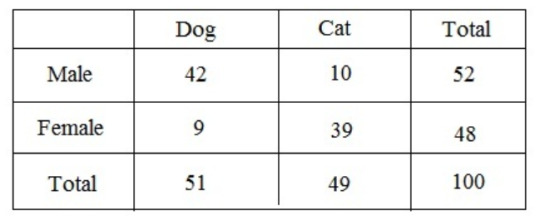
A great way to visualise categorical data is to use a bar plot/chart, which looks something like this:
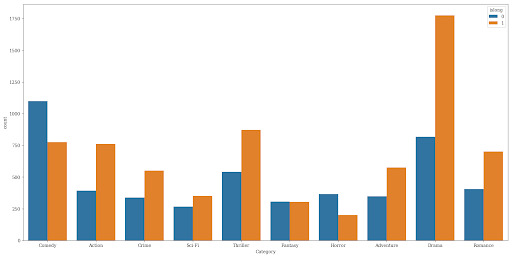
There are two main hypothesis tests for categorical data:
Chi-squared test
Fisher exact test
Chi-squared test:
Compares the distribution of two categorical variables in a contingency table to see if they are related e.g. smoking and prevalence of lung cancer.
Measures difference between what is actually observed in the data and what would be expected if there was truly no relationship between the variables.
Fisher exact test:
Is used instead of Chi-squared when >20% of cells have expected values of <5, or any cell has a count of <1.
If you want to compare several contingency tables for repeated tests of independence i.e. when you have data that you've repeated at different times or locations, you can use the Cochran-Mantel-Haenszel test.
More detail:
In this situation, there are three nominal categorical variables: the two variables of the contingency test of independence, and the third nominal variable that identifies the repeats (such as different times, different locations, or different studies). For example, you conduct an experiment in winter to see whether legwarmers reduce arthritis. With just one set of people, you'd have two nominal variables (legwarmers vs. control, reduced pain vs. same level of pain), each with two values. If you repeated the same experiment in spring, with a new group, and then again in summer, you would have an added variable: different seasons and groups. You could just add the data together and do a Fisher's exact test, but it would be better to keep each of the three experiments separate. Maybe legwarmers work in the winter but not in the summer, or maybe your first set of volunteers had worse arthritis than your second and third sets etc. In addition, combining different studies together can show a "significant" difference in proportions when there isn't one, or even show the opposite of a true difference. This is known as Simpson's paradox. To avoid this, it's better to use the Cochran-Mantel-Haenszel for this type of data.
Testing for normality in continuous data
The first thing you should do before you do ANYTHING else with your continuous data, is determine whether it is or isn’t normally distributed, this will in turn help you choose the correct significance test to analyse your data.
A normal (also known as parametric) distribution is a symmetric distribution where most of the observations cluster around the central peak and the probabilities for values further away from the mean taper off equally in both directions. If plotted, this will look like a symmetrical bell-shaped graph:
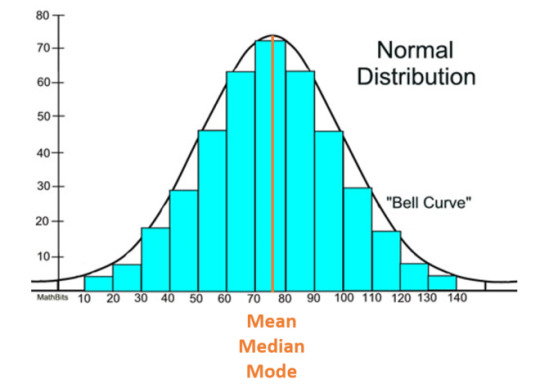
A standard deviation (SD) can be calculated to measure the amount of variation or dispersion of a set of values from the mean. The main and most important purpose of this is to understand how spread out a data set is; a high SD implies that, on average, data points are all pretty far from the average. The opposite is true for a low SD means most points are very close to the average. Generally, smaller variability is better because it represents more precise measurements and yields more accurate analyses..
In a normal distribution, SD will look something like this:
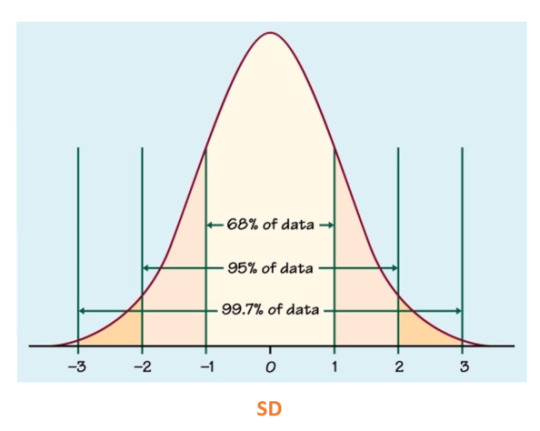
In a normal distribution, skewness (measure of assymetry) and kurtosis (the sharpness of the peak) should be equal to or close to 0, otherwise it becomes a variable distribution.

Testing for normality
Various graphical methods are available to assess the normality of a distribution. The main ones are:
A histogram, which will look something like this:
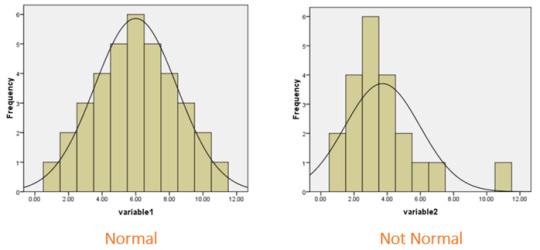
Histograms help visually identify whether the data is normally distributed based on the aforementioned skewness and kurtosis.
A Q-Q plot:
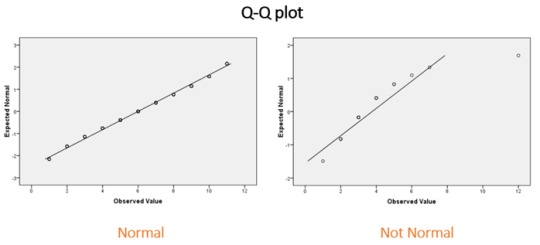
Q-Q plots allow to compare the quantiles of a data set against a theoretical normal distribution. If the majority of points lie on the diagonal line then the data are approximately normal.
and...
A box plot:
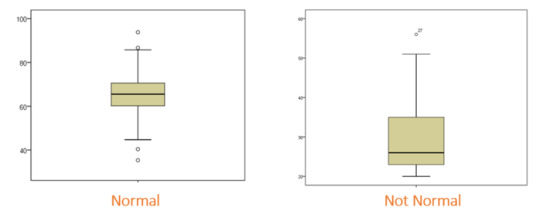
A box plot is an excellent way of displaying continuous data when you are interested in the spread of your data. The thick horizontal bar indicates the median, the top and bottom of the box indicate the interquartile range, and the whiskers represent the spread of data outside of this interquartile range. The dots beyond the whiskers represent outliers, which represent observations that are distant from other observations.
A disadvantage of the box plot is that you don’t see the exact data points. However, box plots are very useful in large datasets where plotting all of the data may give an unclear picture of the shape of your data.
A violin plot is sometimes used in conjunction with the box plot to show density information.
Keep in mind that for real-life data, the results are unlikely to give a perfect plot, so some degree of judgement and prior experience with the data type are required.
Significance tests
Aside from graphical methods, there are also significance tests, which are used to test for normality. These tests compare data to a normal distribution, whereby if the result is significant the distribution is NOT normal.
The three most common tests are:
Shapiro-Wilk Test (sample size <5000)
Anderson-Darling Test (sample size > or = 20)
Kolmogorov-Smirnov Test (sample size > or = 1000)
Significance tests for continuous variables
A quick guide for choosing the appropriate test for your data set:

t-test - normally distributed (parametric) data
There are three types of t-test
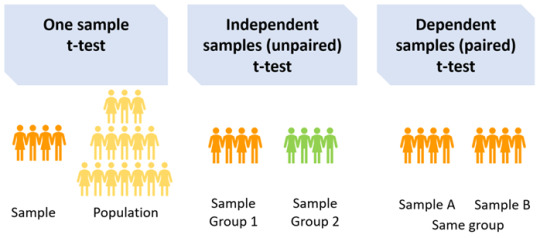
One sample t-test: Compares the mean of the sample with a pre-specified value (population mean) e.g. if the average score of medical students in UK universities is 72 and you want to test whether the average score of medical students in your university is higher/lower, you would need to specify the population mean, in this case 72, when running your t-test.
A two-sample t-test: Should be used if you want to compare the measurements of two populations. There are two types of the two-sample t-test: paired (dependent) and independent (unpaired). To make the correct choice, you need to understand your underlying data.
Dependent samples t-test (paired): Compares the mean between two dependent groups e.g. comparing the average score of medical students at the University of Sheffield before and after attending a revision course, or comparing the mean blood pressure of patients before and after treatment. Independent samples t-test (unpaired): Compares the mean between two independent groups e.g. average score of medical students between University of Sheffield and the University of Leeds, or comparing the mean response of two groups of patients to treatment vs. control in a clinical trial.
There are several assumptions for the independent (unpaired) t-test:
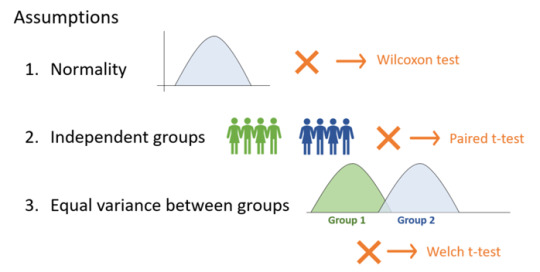
The t-test assumes that the data has equal variance and relies on the data to be normally-distributed. If there isn’t sufficient confidence in this assumption, there are different statistical tests that can be applied. Rather than calculating and comparing the means and variances of different groups they are rank-based methods. However, they still come with a set of assumptions and involve the generation of test statistics and p-values.
Welch t-test, for instance, assumes differences in variance.
Wilcoxon test (also commonly known as the Mann-Whitney U test) can be used when the data is not normally distributed. This test should not be confused with the Wilcoxon signed rank test (which is used for paired tests).
The assumptions of the Wilcoxon/Mann-Whitney U test are as follows:
The dependent variable is ordinal or continuous.
The data consist of a randomly selected sample of independent observations from two independent groups.
The dependent variables for the two independent groups share a similar shape.
Summary of the above:

ANOVA - normally distributed (parametric) data
Like the t-test, there are several types of ANOVA tests:
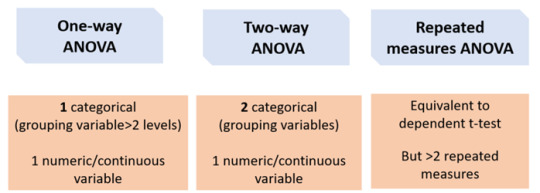
One-way ANOVA:
Equivalent to the independent t-test but for > 2 groups. If you want to compare more than two groups, a one-way ANOVA can be used to simultaneously compare all groups, rather than carrying out several individual two-sample t-tests e.g. to compare the mean of average scores of medical students between the University of Sheffield, the University of Leeds, and the University of Manchester.
The main advantage of doing this is that it reduces the number of tests being carried out, meaning that the type I error rate is also reduced.
Two-way ANOVA: 2 categorical (grouping variables) e.g. comparing the average score of medical students between the University of Sheffield, the University of Leeds, and the University of Manchester AND between males and females.
Repeated measures ANOVA
Equivalent to a paired t-test but for >2 repeated measures e.g. comparing the average score of medical students at University of Sheffield for mid-terms, terms, and finals.
If any of the above ANOVA tests produce a significant result, you also need to carry out a Post-Hoc test.
Post-Hoc test e.g. Tukey HSD
A significant ANOVA result it tells us that there is at least on difference in the groups. However, it does not tell us which group is different. For this, we can apply a post-hoc test such as the Tukey HSD (honest significant difference) test, which is a statistical tool used to determine which sets of data produced a statistically significant result...
For example, for the average scores of medical students between the University of Sheffield, the University of Leeds, and the University of Manchester, the Tukey HSD output may look something like this:

This shows a significant difference between medical students in Manchester and Sheffield and between Leeds and Manchester but not Leeds and Sheffield.
Kruskal Wallis and Friedman tests
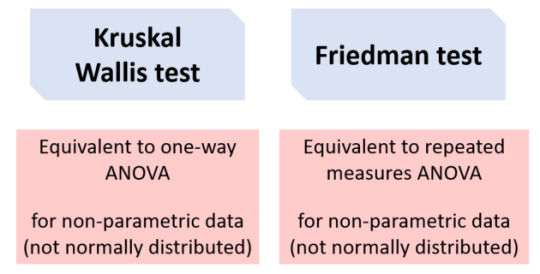
Data that does not meet the assumptions of ANOVA (e.g. normality) can be tested using a non-parametric alternative. The Kruskal-Wallis test is derived from the one-way ANOVA, but uses ranks rather than actual observations. It is also the extension of the Mann-Whitney U test to greater than two groups. Like the one-way ANOVA, this will only tell us that at least one group is different and not specifically which group(s). The Post-Hoc Dunn test is recommended, which also performs a multiple testing correction. For the Friedman test, you can use the Wilcoxon signed-ranks Post-Hoc test. And that is your go-to guide to on how to approach your data! I really hope you find it useful; it definitely helps clarify things for me. ✨
GOOD LUCK!

#diary of a phd student#phd life#phd#bonus post#data analysis#guide#categorical#numerical#data#testing for normality#normal distribution#parametric#non parametric#skewness#kurtosis#science#engineering#ANOVA#t-test#types of data#continuous#discrete#nominal#ordinal#contingency table#chi squared#post hoc tests#kruskal wallis#studyblr#shapiro wilk
88 notes
·
View notes
Text
Friday, January 29, 2021
Seafarers stuck at sea ‘a humanitarian crisis’ (BBC) The fate of more than 200,000 seafarers who play a crucial role in keeping global trade flowing is being labelled a “humanitarian crisis at sea”. More than 300 firms and organisations are urging for them to be treated as “key workers”, so they can return home without risking public health. More than 90% of global trade—from household goods to medical supplies—is moved by sea. But governments have banned crew from coming ashore amid Covid-19 fears. Shipping firms are warning global leaders that ignoring the risk to crews’ mental and physical wellbeing threatens global supply chains, which are crucial to vaccinating the world from coronavirus. Seafarers usually work 10-12 hours shifts, seven days a week to man ships, on four or six-month-long contracts, followed by a period of leave. But due to the coronavirus crisis and travel bans brought in by many governments to combat new variants of Covid-19, hundreds of thousands of crew are spending extended periods at sea, far beyond the expiry of their contracts.
US terrorism alert warns of politically motivated violence (AP) The Department of Homeland Security issued a national terrorism bulletin Wednesday warning of the lingering potential for violence from people motivated by anti-government sentiment after President Joe Biden’s election, suggesting the Jan. 6 riot at the Capitol may embolden extremists and set the stage for additional attacks. The department did not cite any specific plots, but pointed to “a heightened threat environment across the United States” that it believes “will persist” for weeks after Biden’s Jan. 20 inauguration. It is not uncommon for the federal government to warn local law enforcement through bulletins about the prospect for violence tied to a particular event or date, such as July 4. But this particular bulletin, issued through the department’s National Terrorism Advisory System, is notable because it effectively places the Biden administration into the politically charged debate over how to describe or characterize acts motivated by political ideology and suggests that it sees violence aimed at overturning the election as akin to terrorism.
Biden embraces order and routine in his first week (Washington Post) Almost every day of his young tenure, President Biden has entered the State Dining Room, a portrait of Abraham Lincoln looking down and wood burning in the fireplace. He speaks on the planned topic of the day. He sits at an undersized desk and searches for a pen to sign his latest stack of executive orders. Within 30 minutes of entering the camera’s frame, he has left it. It is all plotted and planned. Little room is left for the unscripted or the unusual. Biden’s first full week in office has showcased an almost jarring departure from his predecessor’s chaotic style. The result so far is a 9-to-5 presidency—a tightly scripted burst of activity that was charted over the past few months, as Biden seeks to avoid heated conflict and stick to his plan of lowering the political temperature to a level that many Americans can tune out. The question to be answered in coming weeks, however, is whether Biden’s orderly presidency matches this moment of national urgency, and whether it’s sustainable in the face of multiple crises. Biden himself said last week that the government was on a “wartime” footing—then took the weekend off from public appearances. While former president Donald Trump’s chaotic presidency was unsettling for many Americans, it is unclear for now whether Biden’s more restrained style is an antidote or an overcorrection—and whether he can protect his agenda from being engulfed by the political wars raging around him.
Biden Re-Examining U.S. Arms Sales to Saudi Arabia, U.A.E. (WSJ) The Biden administration has imposed a temporary freeze on U.S. arms sales to Saudi Arabia and is scrutinizing purchases by the United Arab Emirates as it reviews billions of dollars in weapons transactions approved by former President Donald Trump, according to U.S. officials. The review, the officials said, includes the sale of precision-guided munitions to Riyadh, as well as top-line F-35 fighters to Abu Dhabi, a deal that Washington approved as part of the Abraham Accords, in which the Emirates established diplomatic relations with Israel. U.S. officials said it isn’t unusual for a new administration to review arms sales approved by a predecessor, and that despite the pause, many of the transactions are likely to ultimately go forward. But in line with campaign pledges made by President Biden, Washington is seeking to ensure that American weapons aren’t used to further the Saudi-led military campaign in Yemen, where its conflict with the Iranian-aligned Houthis has resulted in thousands of civilian deaths and widespread hunger.
Congress and social media use (Pew Research Center) Though not especially productive in passing bills, the 116th Congress set new marks for social media use. Voting members of the 116th Congress collectively produced more than 2.2 million tweets and Facebook posts in 2019 and 2020. That means the median member of Congress produced more than 3,000 posts across their profiles on the two social media platforms during this span. In total, the 116th Congress produced roughly 738,000 more social media posts than the 114th Congress of 2015-2016, the first one for which the Center has data.
Battling COVID-19 proving deadly for Peru’s doctor corps (AP) Black-and-white pictures of dozens of men and women, some in their 30s and others much older, line the perimeter of a bright yellow building overlooking the Pacific, a two-story-tall black ribbon covering part of the facade and a Peruvian flag at a half-staff near the door. The makeshift memorial is for fallen “pandemic soldiers”—doctors who have died since the coronavirus struck this South American nation last year and unraveled the public health care system. More than 260 doctors have died from the virus in Peru. Their colleagues blame the deaths on a lack of proper personal protective equipment and what they say is the government’s abandonment of the health care system. The Andean country was one of the worst-hit in the region by the pandemic during 2020 and is now experiencing a resurgence in cases. A revolving door of patients, long work shifts, shortage of medical supplies, including oxygen, and lack of protective equipment at hospitals across the country has affected the mental health of doctors. Doctors now warn that Peru could face a crisis of physicians if the government does not take the appropriate steps. Health care professionals have been mounting an open-ended national protest for weeks to press their complaints about inadequate salaries, poor benefits and other working conditions.
English lockdown set to last until at least March, Johnson indicates (Reuters) Prime Minister Boris Johnson indicated on Wednesday the COVID-19 lockdown in England would last until March 8 when schools could start to reopen as the government announced new measures to clamp down on travel to and from Britain. A highly contagious new variant of the virus, which emerged in southeast England at the end of last year, has led to a soaring number of infections across Britain with cases and deaths reaching record levels. England has been in lockdown since the start of January with schools, pubs and restaurants closed and people told to stay home as much as possible. Scotland, Wales and Northern Ireland, whose governments decide on their own measures, are also under various restrictions.
Portugal is in ‘terrible’ phase of pandemic, PM Costa says (Reuters) Portugal is in a terrible phase of the coronavirus pandemic, Prime Minister Antonio Costa said, warning that it would be some weeks before things might start to improve and only limited help could be expected from abroad. With a total of 668,951 confirmed COVID-19 cases and 11,305 deaths, including a record 293 dead on Wednesday, Portugal has the world’s highest seven-day average of new daily cases and deaths per million inhabitants. The situation was not “bad”, it was “terrible”, Costa told the TVI broadcaster overnight. “There is no point in feeding the illusion that we are not facing the worst moment,” he said. “And we’ll face this worst moment for a few more weeks, that is for sure.” More than 20 ambulances with COVID-19 patients queued outside Portugal’s largest hospital on Wednesday evening as they waited for beds to become available, while doctors in other hospitals warned of a risk of the oxygen support system collapsing.
China sharpens language, warns Taiwan that independence ‘means war’ (Reuters) China toughened its language towards Taiwan on Thursday, warning after recent stepped up military activities near the island that “independence means war” and that its armed forces were acting in response to provocation and foreign interference. China believes that Taiwan’s democratically-elected government is moving the island towards a declaration of formal independence, though Taiwan President Tsai Ing-wen has repeatedly said it is already an independent country called the Republic of China, its formal name. Asked at a monthly news briefing about the air force’s recent activities, Chinese Defence Ministry spokesman Wu Qian said Taiwan is an inseparable part of China. “The military activities carried out by the Chinese People’s Liberation Army in the Taiwan Strait are necessary actions to address the current security situation in the Taiwan Strait and to safeguard national sovereignty and security,” he said.
Unrest grows in crisis-hit Lebanon amid coronavirus lockdown (AP) Lebanese security forces fired volleys of tear gas at rock-throwing youth in the northern city of Tripoli on Thursday amid outrage over the country’s coronavirus lockdown and inaction of the political class in the face of economic collapse. The unrelenting protests in Tripoli, now in their fourth day, came as Lebanon grapples with both the pandemic and the worst economic crisis in its history, with only a caretaker government in charge. The protests resumed shortly after Omar Taibi, a 30-year-old who was shot by security forces during protests on Wednesday night, was laid to rest in Tripoli. More than 220 others were injured in the overnight clashes as frustrations boiled over. The demonstrators denounced Lebanon’s extended shutdown that has exacerbated already dire conditions. The confluence of the crises has posed the biggest threat to Lebanon’s stability since the end of its civil war in 1990.
Ultra-Orthodox unrest threatens Netanyahu re-election hopes (AP) As he seeks reelection, Israeli Prime Minister Benjamin Netanyahu has turned to a straightforward strategy: Count on the rock-solid support of his ultra-Orthodox political allies and stamp out the coronavirus pandemic with one of the world’s most aggressive vaccination campaigns. But with ultra-Orthodox communities openly flouting safety guidelines and violently clashing with police trying to enforce them, this marriage of convenience is turning into a burden. Netanyahu has watched his political partners undermine the country’s war against the virus and spark a public backlash that threatens him at the ballot box. “Netanyahu’s hope is that Israel will be the first country in the world to be vaccinated, that he will be able to open the economy to everyone, ultra-Orthodox and secular, and then the problem will be forgotten,” said Moshe Klughaft, a campaign strategist who has advised Netanyahu in the past. If the current troubles persist, he said, “Netanyahu will be in big trouble.” “Israel’s facing a Haredi insurrection that’s making it impossible to fight COVID,” wrote Yaakov Katz, editor of the Jerusalem Post, using the Hebrew word for the ultra-Orthodox.
How far from GameStop to game over? (Reuters) The battle between small-time traders and hedge funds that has shaken U.S. and European stock markets moved into Asia, with surges in several Australian companies squeezing another batch of financial institutions that have bet on the stocks falling. The war began last week when famed short seller Andrew Left of Citron Capital bet against GameStop and was met with a barrage of retail traders [egged on by Reddit users angry at hedge fund profiteering] betting the other way. Consequently, the video game chain rallied as much as 1,700% in two weeks, costing some large short hedge funds billions. The squeeze has made Reddit required reading on Wall Street. Discussions on the social media forum fueled the action around individual stocks. Wall Street saw its worst sell-off since October as funds scrambled to sell their positions in stock market darlings, such as Facebook, Apple and Microsoft, to make up for surging losses from bets made against struggling smaller companies.
1 note
·
View note
Text
Numerology - Does It Really Work?
Like many others, several decades ago, I was attracted to many of the metaphysical sciences and especially numerology.
Though numerology is probably the least known or understood of the metaphysical sciences it is currently enjoying a massive revival. Is this revival due to the current global issues our society is confronted with, and can numerology assist in fixing the issues many are feeling threatened by?
In the very basic of terms numerology is formulated on the idea that everything in the universe is made up of and is affected by numbers. Numerology has been well documented through the eons of civilization and it is now believed that Numerology is probably the oldest science known to man.

In early Hebrew history the interpretation of numbers was considered highly important. Letters of the Hebrew alphabet was based on numbers. It was said that the relationship of the letter and the number were both interconnected with the cosmic forces. Later during the Middle Ages a numerical mysticism evolved from the teachings of Merkabah which was a sect of Judaism. Then in the 13th century the German Kabbalists developed Gematria, a mystic numerical interpretation of the Scriptures.
Evidence also exists regarding the use of numerology thousands of years ago in China, Rome, Japan and Greece. The ancient Greeks have given us a myriad of technological and scientific data that becomes even more relevant as time advances and it is the Greek philosopher Pythagoras with whom we credit for the modern day versions of Numerology. It is very true that Pythagoras did not invent numerology however it was his theories that took numerology to a different level. Hence the reason as to why Pythagoras is credited with being the father of numerology.

From the beginning of the twentieth century several mystics and authors have added their interpretation to form what we have today as modern numerology.
None of this answers the question though - "Does it really work?"
Over these past two decades I have immersed myself in learning what I can in regards to the numbers and how they can affect, influence or assist me in manipulating my every day life.
I used to spend hours wandering through hundreds of Healing Fairs, being engrossed with the various stalls. I have spent hours watching with great anticipation while people handed over their hard earned cash for tarot card readings, astrology charts and the like.
I used to think that just maybe there was something in what many of my friends thought was just a lot of mumbo jumbo.
On one of those many occasions I saw one guy who was doing numerology readings from his lap top. We got chatting and it wasn't long before I had invested in my very own computer numerology program. Now I had already spent hours researching my name, my date of birth, where I lived via what I love to call my numerology bible.
You might ask, why, for what reason did you want to compare the two different systems of numerology. Well my friend my aim was to prove that my so called bible and this computer program would produce different sets of information.
For the first sixth months I had immense fun keying in everything I possible could, each time becoming more and more impressed with the information that I produced.

No, I could not prove that either was wrong, the information was the same and oh so accurate. You might also ask - why is this so? Easy, you see, numbers affect our every day existence because based on name at birth and the date of birth the entire information about one's life is readily available. Things can change in one's life, yet one thing is constant, the date of one's birth.
Over the years the more I study numerology, the more I begin to understand how very substantial readings are. You see your name does literally contain a powerhouse of vital information about your life, your potential and your future. Numerology is a language that allows you to expand the horizon of your spiritual awareness. It opens doors in your psyche that perhaps at this time you do not even know exist.
Remember you are living in a society where no matter what type of job you have, at some stage you have to deal with others. The others could be your boss, your friends, your colleagues, other workers, government officials, your partners, business associates, and your family. The list is endless. You may find that dealing with some people is easy and with others it is difficult. You have to treat or deal with everyone and every situation differently so as to reach what we all call a comfort level otherwise the relationship can be a disaster. No matter what your reason for trying to make an impact on someone, numerology can go a long way towards assisting you in figuring out what makes someone lean in your favor. Consulting the numbers does really work.
I have seen how businesses can work effectively with numerology. Choosing a business name is one of the most important aspects in starting a business. The name that is chosen will represent the image and label of your business and this is an image that must be clearly conveyed to your impending customers. A business name carries a powerful energy that can create great success! Yet it can also be the cause behind a constant struggle with middle-of-the-road performance. So whether you are starting a new company or have an established enterprise, you should really use the numbers to make your business strong and eliminate the areas that may cause disharmony.

Yes numerology does really work. By using numerology in your daily life you can overcome many of the obstacles that just seem to pop up in what you might refer to as a precise and calculated way. Discover simple and quick ways to maximize your energy and reduce your stress! You will learn some really amazing details about your physical, mental, emotional, and 'intuitive' abilities! Why not discover which of these are the strongest and weakest and what they can accomplish for you! Uncover those secrets of your personality, secrets that sometimes even you do not understand fully!
Why does numerology really work? Again the answer is simple - Numerology is a very old and powerful science. It has been developed, improved and enhanced for over 4,000 years by some of the greatest minds and mathematicians in the world and because of all the recent advancements in both mathematics and numerology, readings and calculations can now be done for you that were not possible before.
#numerology#numerology meaning#numerology test#numerology prediction#astrology#spiritulawakening#spiritualgrowth#what is numerology#numbermeanings#numbermessages#birthday number in numerology#birthnumber#spiritualwisdom#spirituality#spiritualguidance#spiritualhealing#soulhealing#healing#spirit healer#devinetiming#devinemessages#devinity#devine#positive thoughts#positiveenergy#positivelife#staypositive#changeyourlife#angel numbers#angelreadings
2 notes
·
View notes